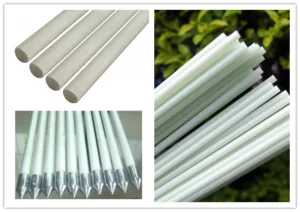Fiberglass fence posts are popular due to their durability, flexibility, and resistance to rot, rust, and insect damage. Making fiberglass fence posts involves a few technical steps typically suited for industrial manufacturing rather than DIY projects, but Unicomposite can provide a simplified overview of the process:

how to make fiberglass fence posts
Materials Preparation: The primary materials used are fiberglass rovings (long strands of fiberglass) and resin (usually polyester or epoxy). These materials are chosen for their strength and weather-resistant properties.
Pultrusion Process:
- Mixing: The fiberglass strands are coated with a resin mixture. This mixture often includes other chemicals that help in curing and enhancing the physical properties of the final product.
- Pulling Through a Die: The resin-coated strands are pulled through a die—a tool that shapes the material into the desired cross-sectional form of the fence post. This process is called “pultrusion.”
- Heating and Curing: As the fiberglass and resin pass through the die, they are heated. This heat triggers the resin to cure (harden), solidifying the shape of the post.
- Cooling and Cutting: After exiting the die, the now-solid fiberglass post is cooled, usually by air or water. Once cooled, it is cut into predetermined lengths suitable for fence posts.
Finishing: The posts may undergo additional processes such as drilling holes for wire attachment, sanding to smooth any sharp edges, and sometimes painting or applying a UV-resistant coating to enhance longevity and appearance.
Quality Control: Throughout the manufacturing process, quality control checks are essential to ensure the posts meet specific strength and durability criteria.
This process requires specialized equipment and expertise, and it’s typically conducted in an industrial setting. For personal or small-scale use, it’s generally more practical to purchase pre-made fiberglass fence posts from a supplier.




























